trailer TOYOTA TACOMA 2012 Owners Manual (in English)
[x] Cancel search | Manufacturer: TOYOTA, Model Year: 2012, Model line: TACOMA, Model: TOYOTA TACOMA 2012Pages: 628, PDF Size: 12.11 MB
Page 3 of 628

1
2
3
4
5
6
7
3
2-4. Using other driving systemsCruise control ...................... 174
Rear view monitor system (vehicles with auto
anti-glare inside rear
view mirror) ....................... 178
Four-wheel drive system ..... 186
Active traction control system .............................. 190
AUTO LSD system.............. 192
Rear differential lock system .............................. 194
Downhill Assist Control system .............................. 197
Clutch start cancel switch ... 199
Driving assist systems ........ 200
2-5. Driving information Off-road precautions (4WD models and
PreRunner) ....................... 207
Cargo and luggage ............. 212
Vehicle load limits ............... 217
Winter driving tips ............... 219
Trailer towing ...................... 223
Dinghy towing ..................... 244 3-1. Using the air conditioning
system and defogger
Air conditioning system ...... 248
3-2. Using the audio system Audio system types ............ 255
Using the radio ................... 260
Using the CD player ........... 267
Playing MP3 and WMA discs ................................. 273
Operating an iPod .............. 280
Operating a USB memory ............................ 288
Optimal use of the audio system .............................. 295
Operating the sub woofer (on some Access Cab
models) ............................ 300
Using the AUX port............. 301
Using the steering wheel audio switches.................. 303
Detachable pole antenna ... 306
3-3. Using the Bluetooth
® audio
system
Bluetooth
® audio system .... 309
Using the Bluetooth®
audio system .................... 312
Operating a Bluetooth
®
enabled portable player.... 318
Setting up a Bluetooth
®
enabled portable player.... 320
Bluetooth
® audio system
setup ................................ 325
3Interior and exterior
features
Page 131 of 628
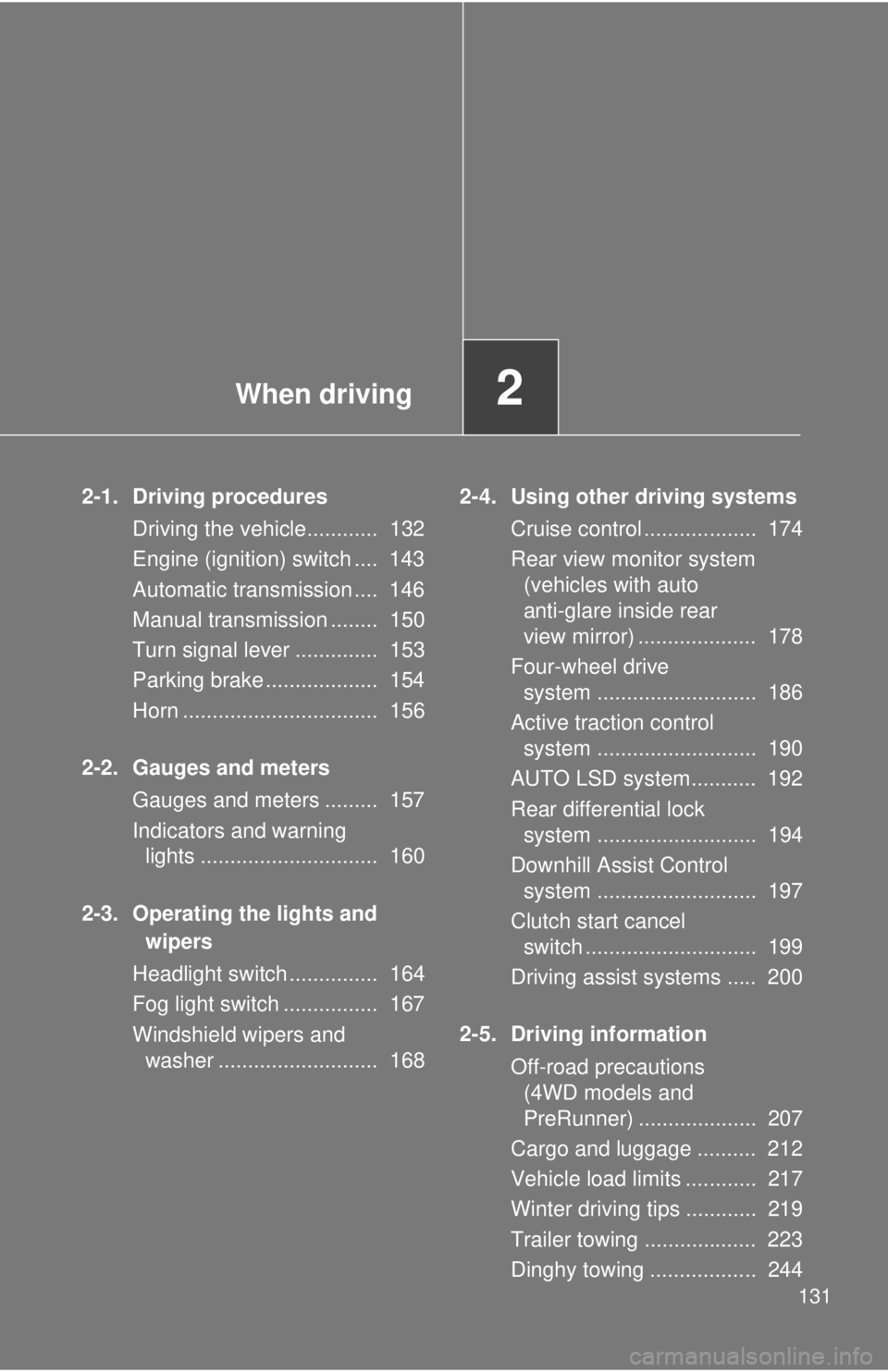
When driving2
131
2-1. Driving proceduresDriving the vehicle............ 132
Engine (ignition) switch .... 143
Automatic transmission .... 146
Manual transmission ........ 150
Turn signal lever .............. 153
Parking brake ................... 154
Horn ................................. 156
2-2. Gauges and meters Gauges and meters ......... 157
Indicators and warning lights .............................. 160
2-3. Operating the lights and wipers
Headlight switch ............... 164
Fog light switch ................ 167
Windshield wipers and washer ........................... 168 2-4. Using other driving systems
Cruise control ................... 174
Rear view monitor system (vehicles with auto
anti-glare inside rear
view mirror) .................... 178
Four-wheel drive system ........................... 186
Active traction control system ........................... 190
AUTO LSD system........... 192
Rear differential lock system ........................... 194
Downhill Assist Control system ........................... 197
Clutch start cancel switch ............................. 199
Driving assist systems ..... 200
2-5. Driving information Off-road precautions (4WD models and
PreRunner) .................... 207
Cargo and luggage .......... 212
Vehicle load limits ............ 217
Winter driving tips ............ 219
Trailer towing ................... 223
Dinghy towing .................. 244
Page 134 of 628
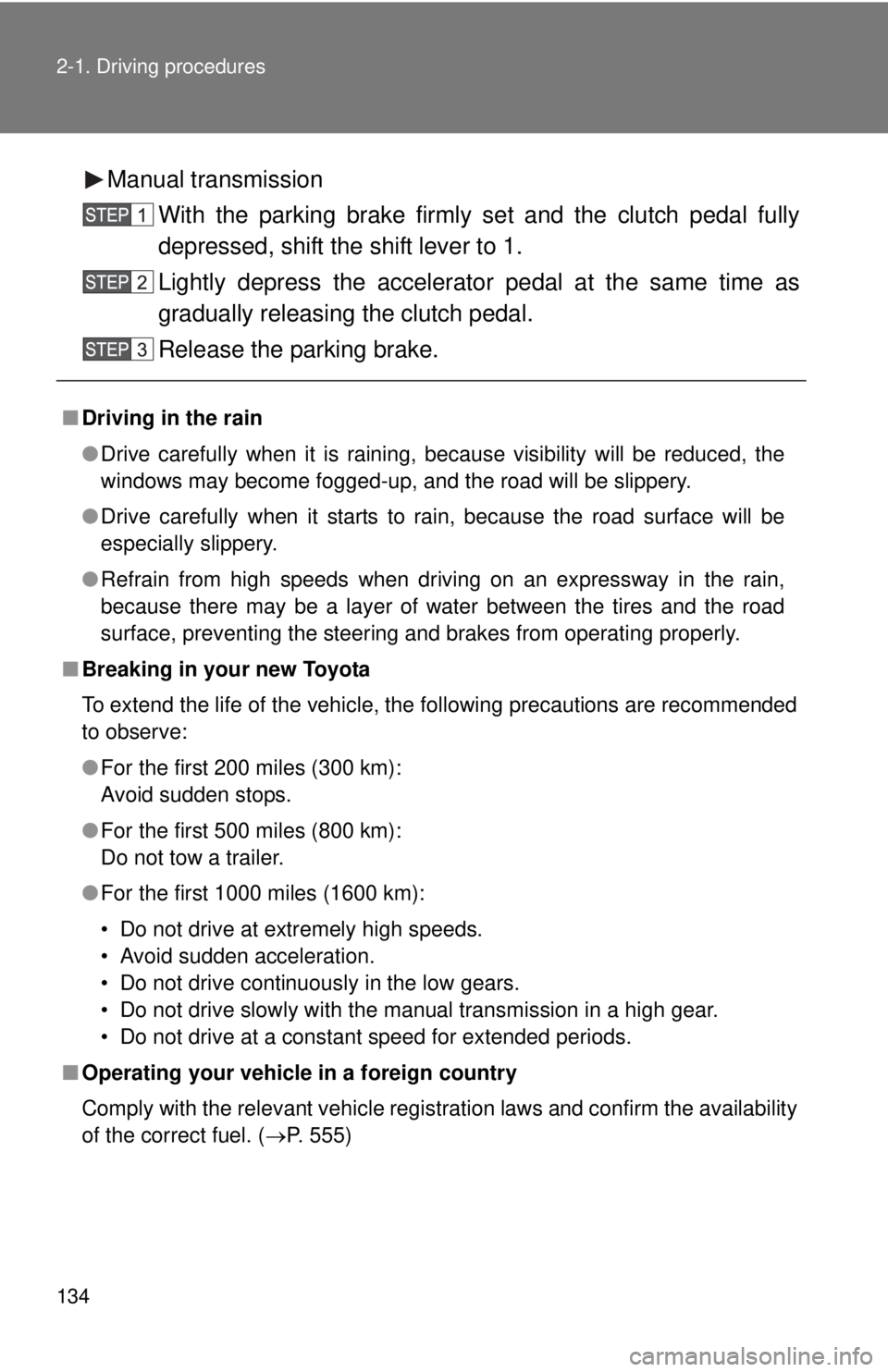
134 2-1. Driving procedures
Manual transmissionWith the parking brake firmly set and the clutch pedal fully
depressed, shift the shift lever to 1.
Lightly depress the accelerator pedal at the same time as
gradually releasing the clutch pedal.
Release the parking brake.
■Driving in the rain
●Drive carefully when it is raining, because visibility will be reduced, the
windows may become fogged-up, and the road will be slippery.
● Drive carefully when it starts to rain, because the road surface will be
especially slippery.
● Refrain from high speeds when driving on an expressway in the rain,
because there may be a layer of water between the tires and the road
surface, preventing the steering and brakes from operating properly.
■ Breaking in your new Toyota
To extend the life of the vehicle, the following precautions are recommended
to observe:
●For the first 200 miles (300 km):
Avoid sudden stops.
● For the first 500 miles (800 km):
Do not tow a trailer.
● For the first 1000 miles (1600 km):
• Do not drive at extremely high speeds.
• Avoid sudden acceleration.
• Do not drive continuously in the low gears.
• Do not drive slowly with the manual transmission in a high gear.
• Do not drive at a constant speed for extended periods.
■ Operating your vehicle in a foreign country
Comply with the relevant vehicle registration laws and confirm the availability
of the correct fuel. ( P. 555)
Page 139 of 628
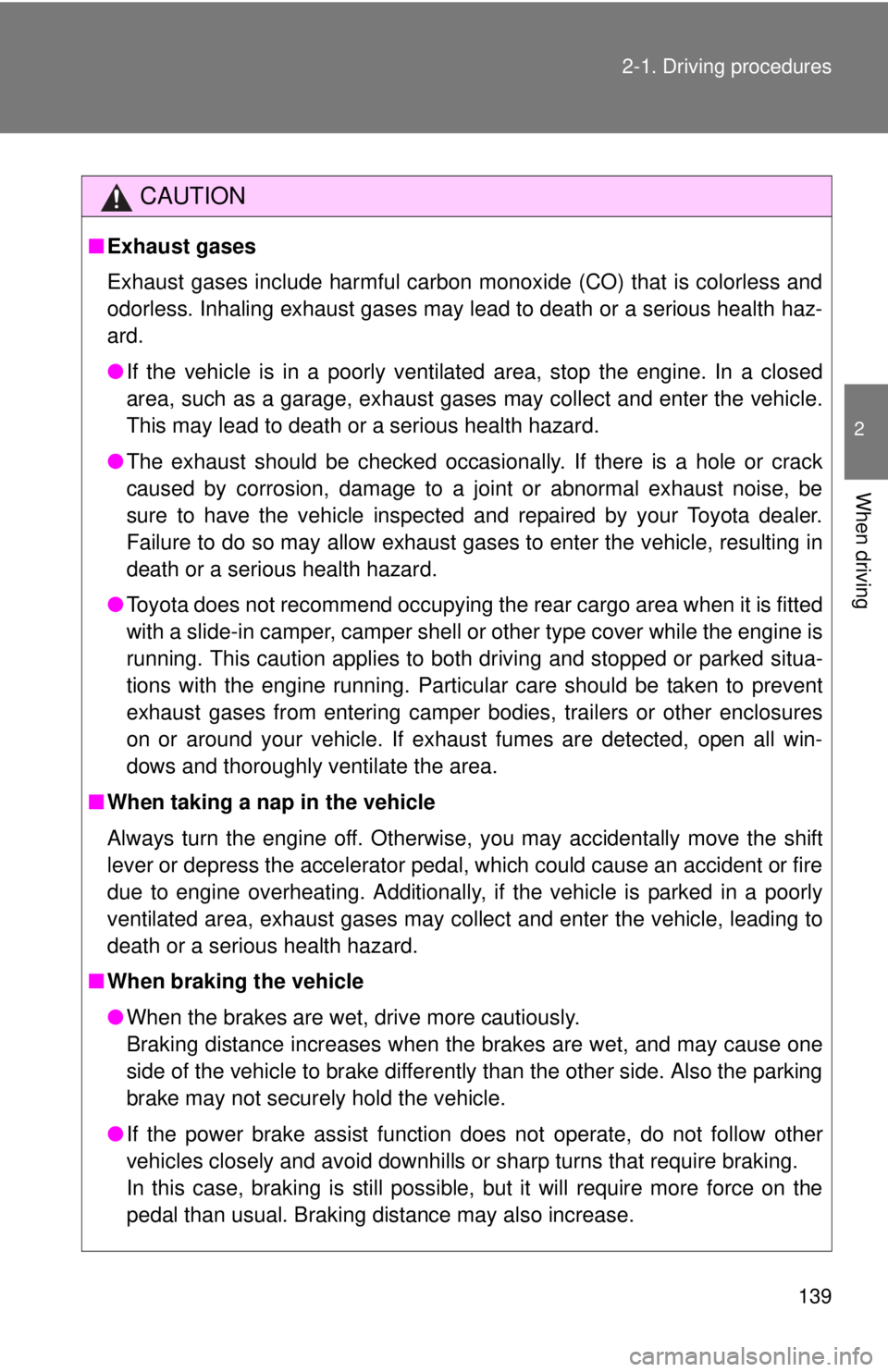
139
2-1. Driving procedures
2
When driving
CAUTION
■
Exhaust gases
Exhaust gases include harmful carbon monoxide (CO) that is colorless and
odorless. Inhaling exhaust gases may lead to death or a serious health haz-
ard.
●If the vehicle is in a poorly ventilated area, stop the engine. In a closed
area, such as a garage, exhaust gases may collect and enter the vehicle.
This may lead to death or a serious health hazard.
● The exhaust should be checked occasionally. If there is a hole or crack
caused by corrosion, damage to a joint or abnormal exhaust noise, be
sure to have the vehicle inspected and repaired by your Toyota dealer.
Failure to do so may allow exhaust gases to enter the vehicle, resulting in
death or a serious health hazard.
● Toyota does not recommend occupying the rear cargo area when it is fitted
with a slide-in camper, camper shell or other type cover while the engine is
running. This caution applies to both driving and stopped or parked situa-
tions with the engine running. Particular care should be taken to prevent
exhaust gases from entering camper bodies, trailers or other enclosures
on or around your vehicle. If exhaust fumes are detected, open all win-
dows and thoroughly ventilate the area.
■ When taking a nap in the vehicle
Always turn the engine off. Otherwise, you may accidentally move the shift
lever or depress the accelerator pedal, which could cause an accident or fire
due to engine overheating. Additionally, if the vehicle is parked in a poorly
ventilated area, exhaust gases may collect and enter the vehicle, leadin\
g to
death or a serious health hazard.
■ When braking the vehicle
●When the brakes are wet, drive more cautiously.
Braking distance increases when the brakes are wet, and may cause one
side of the vehicle to brake differently than the other side. Also the parking
brake may not securely hold the vehicle.
● If the power brake assist function does not operate, do not follow other
vehicles closely and avoid downhills or sharp turns that require braking.
In this case, braking is still possible, but it will require more force on the
pedal than usual. Braking distance may also increase.
Page 177 of 628
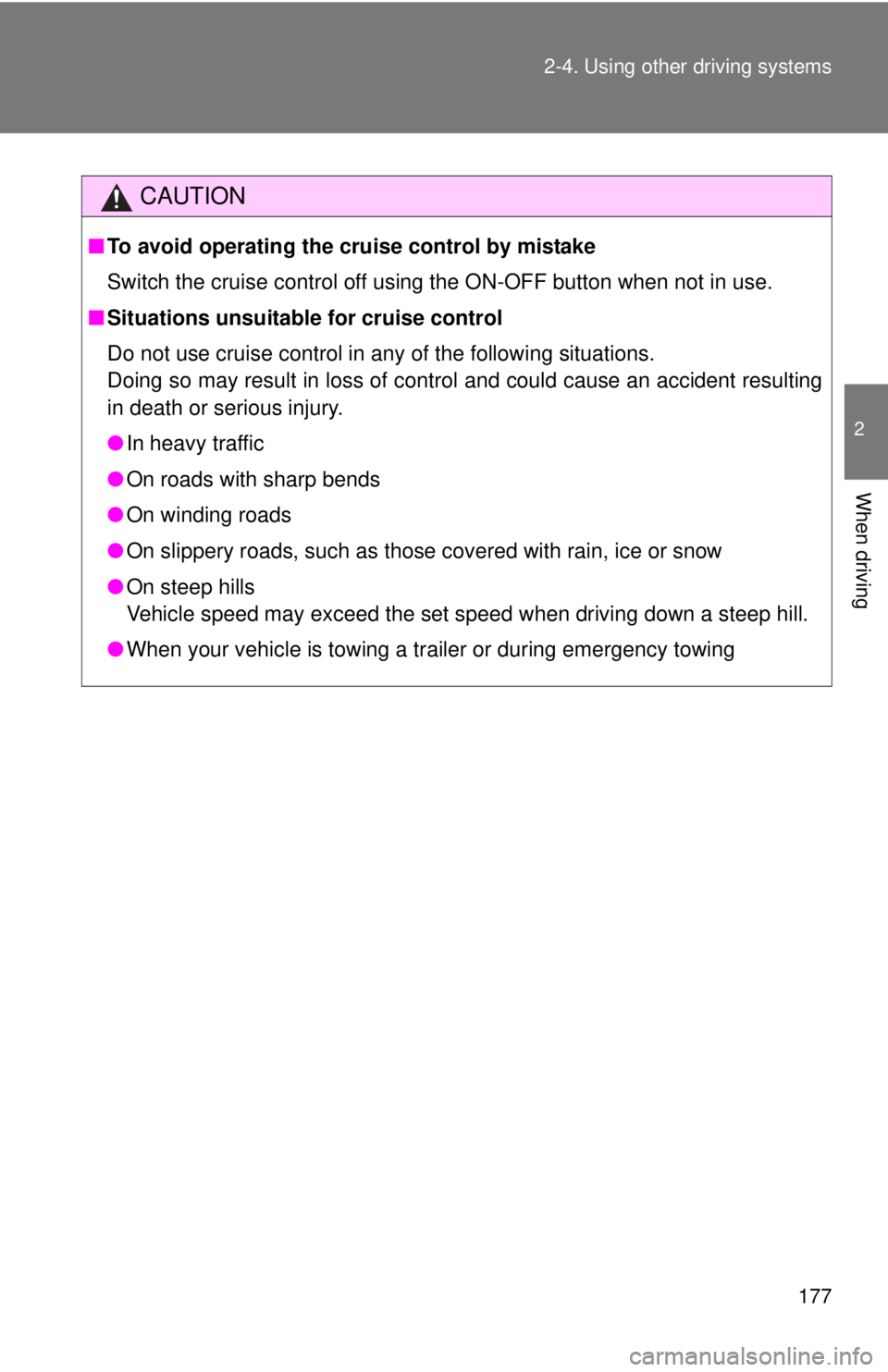
177
2-4. Using other
driving systems
2
When driving
CAUTION
■To avoid operating the cruise control by mistake
Switch the cruise control off using the ON-OFF button when not in use.
■ Situations unsuitable for cruise control
Do not use cruise control in any of the following situations.
Doing so may result in loss of control and could cause an accident resulting
in death or serious injury.
●In heavy traffic
● On roads with sharp bends
● On winding roads
● On slippery roads, such as those covered with rain, ice or snow
● On steep hills
Vehicle speed may exceed the set speed when driving down a steep hill.
● When your vehicle is towing a trailer or during emergency towing
Page 200 of 628
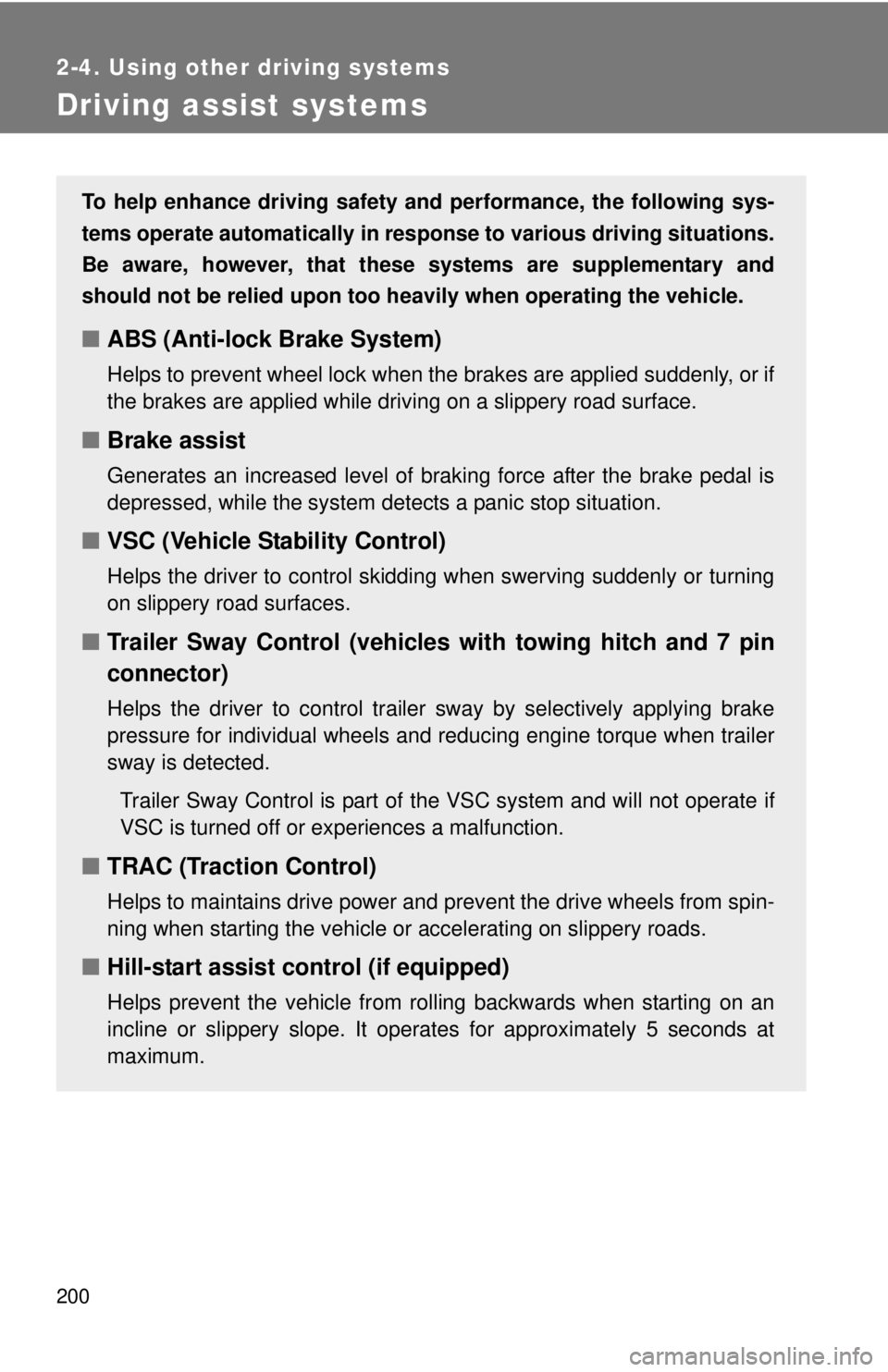
200
2-4. Using other driving systems
Driving assist systems
To help enhance driving safety and performance, the following sys-
tems operate automatically in res ponse to various driving situations.
Be aware, however, that these systems are supplementary and
should not be relied upon too h eavily when operating the vehicle.
■ABS (Anti-lock Brake System)
Helps to prevent wheel lock when the brakes are applied suddenly, or if
the brakes are applied while driving on a slippery road surface.
■Brake assist
Generates an increased level of braking force after the brake pedal is
depressed, while the system detects a panic stop situation.
■VSC (Vehicle Stability Control)
Helps the driver to control skidding when swerving suddenly or turning
on slippery road surfaces.
■Trailer Sway Control (vehicl es with towing hitch and 7 pin
connector)
Helps the driver to control trailer sway by selectively applying brake
pressure for individual wheels and reducing engine torque when trailer
sway is detected.
Trailer Sway Control is part of the VSC system and will not operate if
VSC is turned off or experiences a malfunction.
■ TRAC (Traction Control)
Helps to maintains drive power and prevent the drive wheels from spin-
ning when starting the vehicle or accelerating on slippery roads.
■Hill-start assist control (if equipped)
Helps prevent the vehicle from rolling backwards when starting on an
incline or slippery slope. It operates for approximately 5 seconds at
maximum.
Page 201 of 628
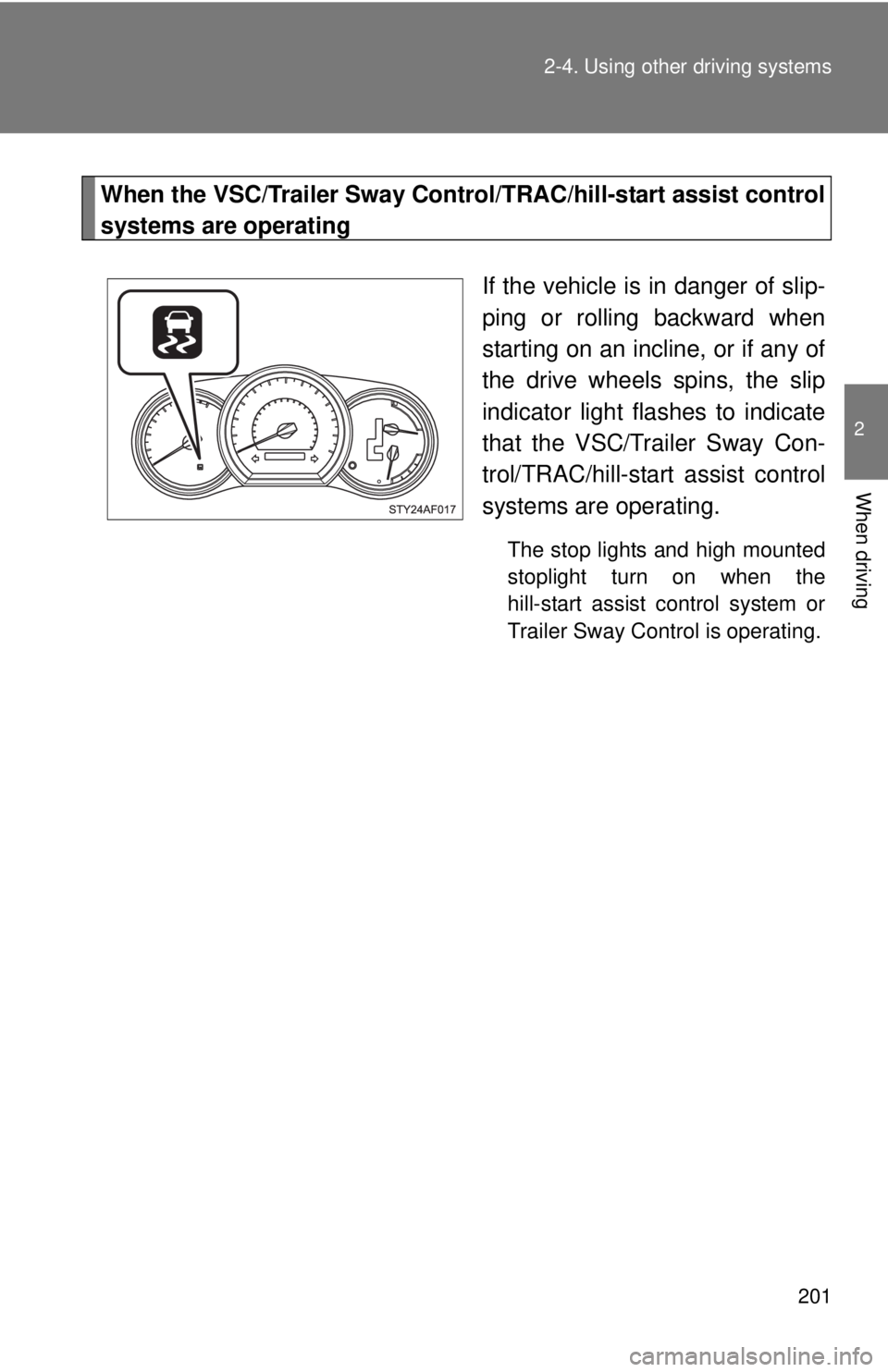
201
2-4. Using other
driving systems
2
When driving
When the VSC/Trailer Sway Control/TRAC/hill-start assist control
systems are operating
If the vehicle is in danger of slip-
ping or rolling backward when
starting on an incline, or if any of
the drive wheels spins, the slip
indicator light flashes to indicate
that the VSC/Trailer Sway Con-
trol/TRAC/hill-start assist control
systems are operating.
The stop lights and high mounted
stoplight turn on when the
hill-start assist control system or
Trailer Sway Control is operating.
Page 202 of 628
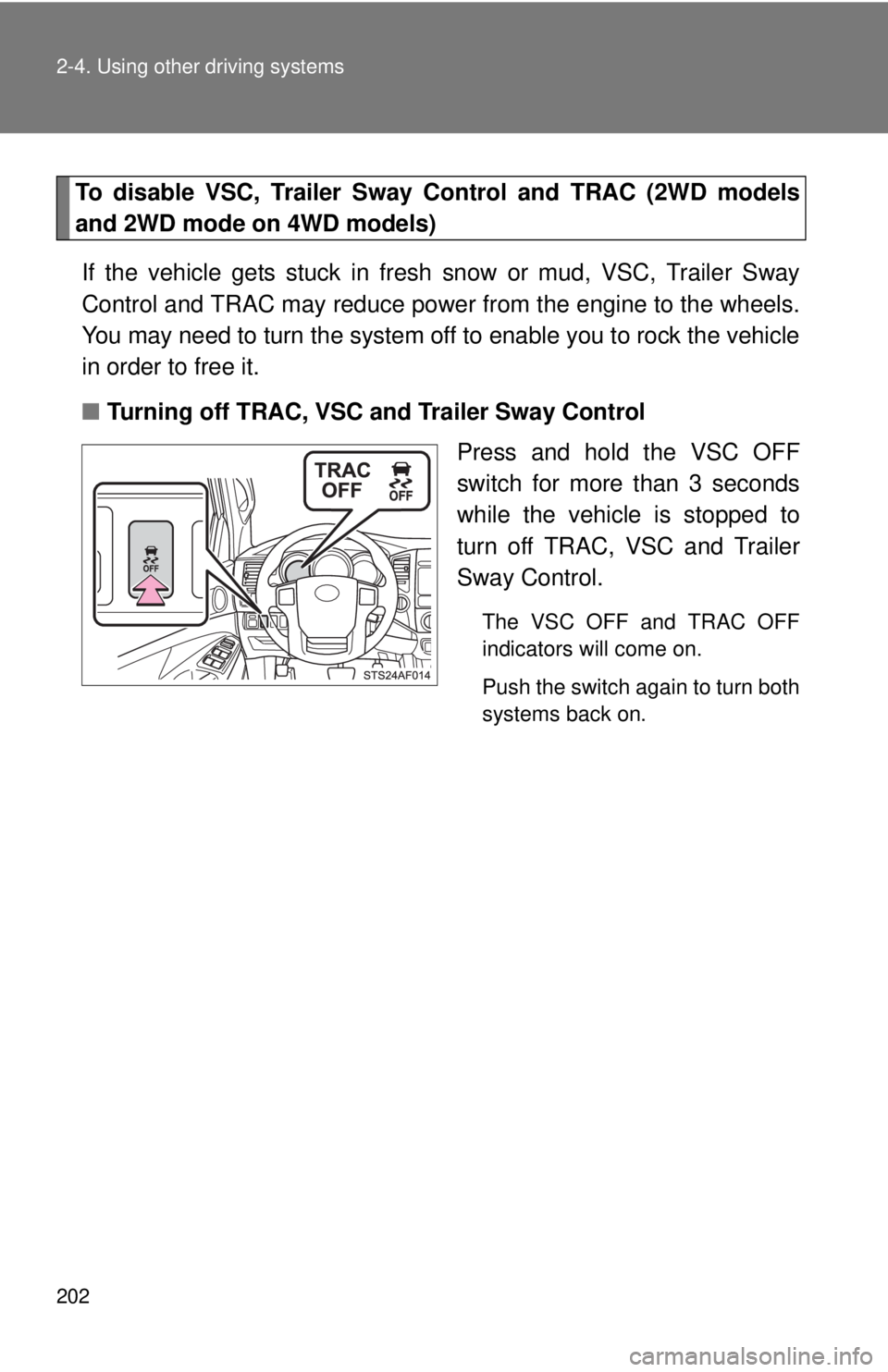
202 2-4. Using other driving systems
To disable VSC, Trailer Sway Control and TRAC (2WD models
and 2WD mode on 4WD models)
If the vehicle gets stuck in fresh snow or mud, VSC, Trailer Sway
Control and TRAC may reduce power from the engine to the wheels.
You may need to turn the system off to enable you to rock the vehicle
in order to free it.
■ Turning off TRAC, VSC and Trailer Sway Control
Press and hold the VSC OFF
switch for more than 3 seconds
while the vehicle is stopped to
turn off TRAC, VSC and Trailer
Sway Control.
The VSC OFF and TRAC OFF
indicators will come on.
Push the switch again to turn both
systems back on.
Page 203 of 628
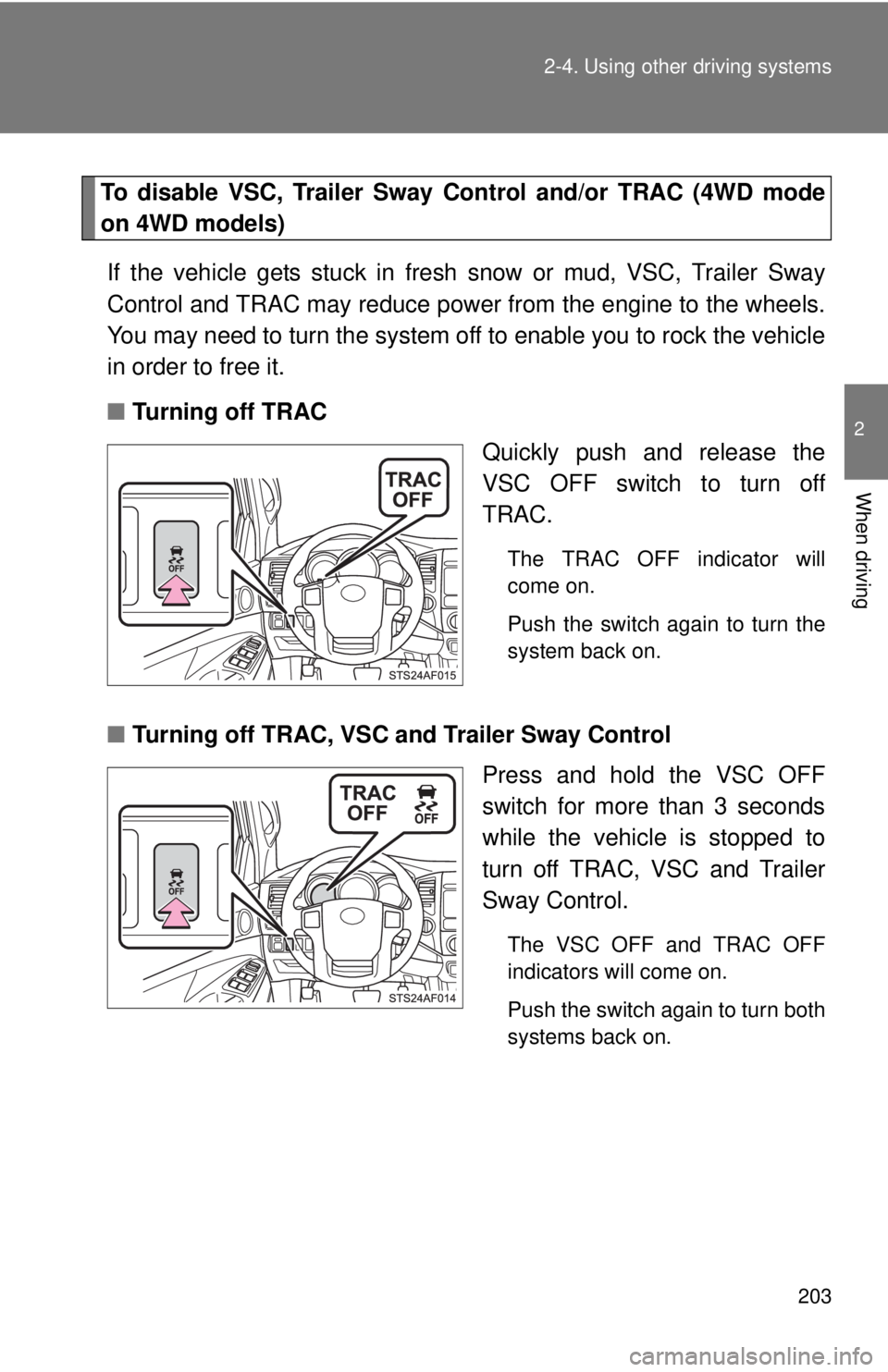
203
2-4. Using other
driving systems
2
When driving
To disable VSC, Trailer Sway C ontrol and/or TRAC (4WD mode
on 4WD models)
If the vehicle gets stuck in fresh snow or mud, VSC, Trailer Sway
Control and TRAC may reduce power from the engine to the wheels.
You may need to turn the system off to enable you to rock the vehicle
in order to free it.
■ Turning off TRAC
Quickly push and release the
VSC OFF switch to turn off
TRAC.
The TRAC OFF indicator will
come on.
Push the switch again to turn the
system back on.
■Turning off TRAC, VSC and Trailer Sway Control
Press and hold the VSC OFF
switch for more than 3 seconds
while the vehicle is stopped to
turn off TRAC, VSC and Trailer
Sway Control.
The VSC OFF and TRAC OFF
indicators will come on.
Push the switch again to turn both
systems back on.
Page 204 of 628

204 2-4. Using other driving systems
■When the TRAC OFF indicator light comes on even if the VSC OFF
switch has not been pressed
TRAC, hill-start assist control, downhill assist control system cannot be oper-
ated. Contact your Toyota dealer.
■ Reactivation of the TRAC, VSC and Trailer Sway Control systems after
turning off the engine
Turning off the engine after turning off the TRAC, VSC and Trailer Sway
Control systems will automatically reactivate them.
■ Automatic TRAC reactivation (AUTO LSD mode)
With AUTO LSD mode, VSC OFF and AUTO LSD indicator lights turn on.
The TRAC system will turn on when the vehicle speed increases.
■ Automatic TRAC, VSC and Trai ler Sway Control reactivation
If the TRAC, VSC and Trailer Sway Control systems are turned off, the sys-
tems will not turn on even when vehicle speed increases.
■ Sounds and vibrations caused by the ABS, TRAC, VSC, Trailer Sway
Control, brake assist and hill-start assist control system
● A sound may be heard from the engine compartment when the engine is
started or just after the vehicle begins to move. This sound does not indi-
cate that a malfunction has occurred in any of these systems.
● Any of the following conditions may occur when the above systems are
operating. None of these indicates that a malfunction has occurred.
• Vibrations may be felt through the vehicle body and steering.
• A motor sound may be heard after the vehicle comes to a stop.
• The brake pedal may pulsate slightly when the ABS is activated.
• The brake pedal may move down slightly after the ABS is activated.
■ Hill-start assist control is op erational when (if equipped)
● The shift lever is in the D, 4, 3, 2 (5-speed automatic transmission), D, 3,
2 (4-speed automatic transmission) or L positions.
● The brake pedal is not depressed.